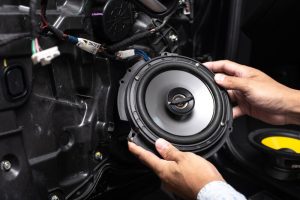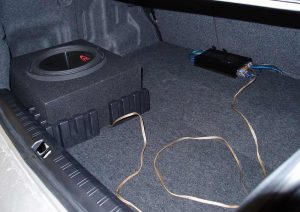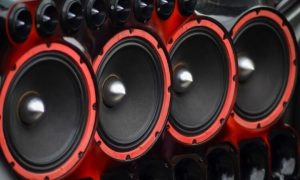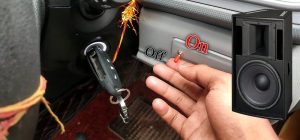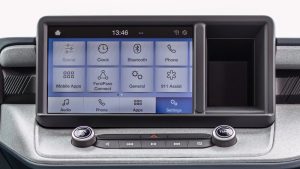Car stereos transform your driving experience, delivering music, podcasts, and navigation right to your dashboard. But when you shop for a new head unit, you often encounter the term “DIN.” What does DIN mean in car stereo systems? Why does it matter? This comprehensive guide breaks down everything you need to know about DIN sizes, their importance, and how they impact your car audio setup. By the end, you’ll confidently choose the right stereo for your vehicle.
Contents
- Understanding DIN in Car Stereos
- Why DIN Size Matters
- Single DIN: Compact and Versatile
- Double DIN: Bigger and Feature-Packed
- Half DIN and Other Variations
- How to Determine Your Car’s DIN Size
- Installation Considerations for DIN Stereos
- Choosing Between Single DIN and Double DIN
- Popular Brands for DIN Stereos
- Enhancing Your Car Audio Experience
- Common Mistakes to Avoid
- The Future of DIN Stereos
- FAQs About DIN Car Stereos
- Conclusion
Understanding DIN in Car Stereos
DIN stands for Deutsches Institut für Normung, a German standards organization that sets industrial and technical benchmarks. In the context of car stereos, DIN refers to a standardized size for head units, ensuring compatibility between stereos and vehicle dashboards. This standard simplifies the process of replacing or upgrading your car’s audio system.
The DIN standard emerged in the 1980s, when car manufacturers and audio companies needed a universal size for stereos. Before DIN, head units varied wildly, making upgrades a headache. With DIN, you can confidently buy a stereo knowing it fits your car’s dashboard slot, provided you understand the specific DIN size.
Why DIN Size Matters
Choosing the right DIN size ensures your new stereo fits seamlessly into your vehicle. A mismatched size leads to installation issues, unsightly gaps, or the need for costly adapters. DIN sizes also influence the features available in a head unit. Larger stereos often include advanced options like touchscreens, while smaller ones prioritize simplicity.
When you shop for a car stereo, you’ll encounter two main DIN sizes: Single DIN and Double DIN. Each serves different vehicles and user needs. Let’s dive into both, so you can pick the perfect fit.
Single DIN: Compact and Versatile
A Single DIN stereo measures approximately 2 inches tall and 7 inches wide. This compact size fits older vehicles or cars with smaller dashboard spaces. Despite its smaller footprint, Single DIN units pack a punch, offering features like Bluetooth, USB ports, and smartphone integration.
Benefits of Single DIN Stereos
Single DIN stereos shine in their simplicity and affordability. They fit a wide range of vehicles, from classic cars to budget-friendly models. Many drivers prefer Single DIN for its straightforward controls, which reduce distractions on the road. You’ll find these units in brands like Pioneer, Kenwood, and Sony, delivering reliable performance without breaking the bank.
For example, a Single DIN stereo with Bluetooth lets you stream music or take hands-free calls. Some models even support Apple CarPlay or Android Auto, bridging the gap between basic and advanced functionality. If your car has a narrow dashboard slot, a Single DIN unit is likely your best bet.
Drawbacks of Single DIN
The main limitation of Single DIN stereos is their small display. Most rely on basic LCD screens, which lack the visual appeal of larger touchscreens. If you want a modern interface with navigation or video playback, Single DIN might feel restrictive. Still, for drivers focused on audio quality and ease of use, these units deliver.
Double DIN: Bigger and Feature-Packed
A Double DIN stereo doubles the height of a Single DIN, measuring about 4 inches tall and 7 inches wide. This larger size accommodates vibrant touchscreens and more advanced features, making Double DIN units popular in modern vehicles. If your car’s dashboard has a taller slot, a Double DIN stereo offers a sleek, high-tech upgrade.
Advantages of Double DIN Stereos
Double DIN stereos elevate your car’s interior with large, responsive displays. These units often include Apple CarPlay, Android Auto, built-in GPS, and even DVD players. The bigger screen makes navigation intuitive, letting you view maps or control apps with ease. Brands like Alpine, JVC, and Clarion dominate this category, offering premium models for tech-savvy drivers.
For instance, a Double DIN stereo with a 7-inch touchscreen transforms your dashboard into a multimedia hub. You can stream Spotify, watch videos (when parked), or integrate a backup camera for safer reversing. The larger size also allows for customizable interfaces, so you can prioritize your favorite features.
Challenges of Double DIN
Double DIN stereos cost more than their Single DIN counterparts, with prices often starting at $150 and climbing to $500 or higher for premium models. Installation can also be trickier, especially in older cars not designed for larger units. You might need a dash kit or professional help to ensure a snug fit. Despite these hurdles, the enhanced functionality often justifies the investment.
Half DIN and Other Variations
While Single DIN and Double DIN dominate, you might encounter less common sizes like Half DIN or 1.5 DIN. Half DIN units, often used in older vehicles, are smaller than Single DIN and typically found in factory-installed systems. 1.5 DIN stereos fall between Single and Double DIN, but they’re rare and often specific to certain car brands.
These non-standard sizes can complicate upgrades. If your vehicle uses a Half DIN or 1.5 DIN slot, you may need adapters or custom modifications to install a modern stereo. Always check your car’s manual or consult a professional to confirm compatibility.
How to Determine Your Car’s DIN Size
Before buying a new stereo, verify your vehicle’s DIN size. Start by checking your car’s owner’s manual, which often specifies the dashboard slot dimensions. You can also measure the existing stereo’s faceplate with a ruler. A height of about 2 inches indicates Single DIN, while 4 inches suggests Double DIN.
If you’re unsure, visit an auto parts store or car audio shop. Professionals can assess your dashboard and recommend compatible units. Online tools, like Crutchfield’s vehicle selector, also help by matching stereos to your car’s make and model.
Installation Considerations for DIN Stereos
Installing a DIN-sized stereo requires some preparation. While Single DIN units often slide into place with minimal effort, Double DIN installations may need extra steps. Here’s what to keep in mind:
- Dash Kits: If your car’s dashboard doesn’t perfectly match the new stereo’s size, a dash kit creates a seamless fit. These kits fill gaps and maintain a factory-like appearance.
- Wiring Harnesses: A wiring harness simplifies connections between your car’s electrical system and the new stereo. Match the harness to your vehicle and stereo brand for plug-and-play ease.
- Tools: Basic tools like screwdrivers, wire strippers, and a trim removal kit help with installation. For complex setups, consider professional assistance.
- Compatibility: Ensure the stereo’s features align with your car’s capabilities. For example, if you want a backup camera, confirm your vehicle supports it.
Proper installation enhances your stereo’s performance and prevents issues like loose fittings or electrical shorts. If you’re new to car audio, watch YouTube tutorials or hire a technician for peace of mind.
Choosing Between Single DIN and Double DIN
Deciding between Single DIN and Double DIN depends on your vehicle, budget, and preferences. Ask yourself these questions:
- What’s my car’s dashboard size? Measure your slot or check your manual to confirm Single or Double DIN compatibility.
- Do I need advanced features? If you want touchscreens, navigation, or video playback, Double DIN is the way to go. For basic audio, Single DIN suffices.
- What’s my budget? Single DIN units are generally cheaper, while Double DIN offers more for a higher price.
- Am I comfortable with installation? Single DIN is easier to install, while Double DIN may require extra parts or professional help.
For example, a budget-conscious driver with an older car might choose a Single DIN Pioneer unit with Bluetooth for under $100. A tech enthusiast with a newer SUV might opt for a Double DIN Kenwood stereo with Apple CarPlay for $300. Weigh your needs to make the right call.
Popular Brands for DIN Stereos
Several brands excel in producing DIN-sized car stereos, catering to different budgets and preferences. Here are some top picks:
- Pioneer: Known for reliable Single and Double DIN units with excellent sound quality and smartphone integration.
- Kenwood: Offers feature-rich Double DIN stereos with vibrant displays and robust connectivity options.
- Sony: Delivers affordable Single DIN models and premium Double DIN units with sleek designs.
- Alpine: Specializes in high-end Double DIN stereos with superior audio performance and customization.
- JVC: Balances affordability and features, ideal for budget-conscious buyers seeking modern tech.
Research models from these brands to find one that matches your vehicle and audio goals. Customer reviews on sites like Amazon or Best Buy provide real-world insights into performance and durability.
Enhancing Your Car Audio Experience
A DIN-sized stereo is just the start of a great car audio system. To maximize your setup, consider these upgrades:
- Speakers: Upgrading factory speakers improves sound clarity and bass. Brands like Focal, Kicker, and JL Audio offer high-quality options.
- Amplifiers: An amp boosts your stereo’s power, delivering louder, cleaner audio. Match the amp’s wattage to your speakers for optimal results.
- Subwoofers: For deep bass, add a subwoofer. Compact models fit in tight spaces, while larger ones pack a punch.
- Sound Deadening: Apply sound-deadening mats to your car’s doors and floor to reduce road noise and enhance audio quality.
These additions complement your DIN stereo, creating a concert-like experience on the road. Start with one upgrade at a time to stay within budget.
Common Mistakes to Avoid
When upgrading your car stereo, steer clear of these pitfalls:
- Ignoring DIN Size: Buying a stereo without checking your car’s slot size leads to compatibility issues. Always measure or research first.
- Skipping Wiring Harnesses: Hardwiring a stereo without a harness risks electrical problems. Invest in a vehicle-specific harness for safety.
- Overlooking Installation Costs: Double DIN units may require dash kits or professional installation, adding to your budget. Factor in these expenses upfront.
- Choosing Features You Don’t Need: A Double DIN with video playback sounds cool but may be overkill if you only listen to music. Prioritize what you’ll actually use.
By planning carefully, you’ll avoid headaches and enjoy your new stereo sooner.
The Future of DIN Stereos
As cars evolve, so do car stereos. Modern vehicles increasingly integrate infotainment systems with factory-installed Double DIN units. However, aftermarket DIN stereos remain popular for their customization and affordability. Emerging trends include:
- Wireless Connectivity: More stereos offer wireless Apple CarPlay and Android Auto, reducing cable clutter.
- Voice Assistants: Integration with Siri, Google Assistant, and Alexa makes hands-free control easier.
- High-Resolution Displays: Double DIN units now feature HD screens for sharper visuals and smoother touch response.
- Smartphone Mirroring: Advanced stereos let you mirror your phone’s screen, accessing apps directly from the dashboard.
These innovations ensure DIN stereos stay relevant, even as cars become more connected. Keep an eye on new releases from top brands to stay ahead of the curve.
FAQs About DIN Car Stereos
What’s the difference between Single DIN and Double DIN?
Single DIN stereos are 2 inches tall, ideal for smaller dashboards and basic features. Double DIN units are 4 inches tall, offering larger touchscreens and advanced options like navigation.
Can I install a Double DIN stereo in a Single DIN slot?
Not without modifications. You’ll need a dash kit and possibly professional installation to adapt a Double DIN unit to a Single DIN slot.
Do all cars use DIN sizes?
Most modern cars follow DIN standards, but some older or luxury vehicles use custom sizes. Check your car’s manual or consult a professional.
Are Double DIN stereos better than Single DIN?
Not necessarily. Double DIN offers more features, but Single DIN is simpler and fits more vehicles. Choose based on your needs and car’s compatibility.
How do I know if a stereo fits my car?
Measure your dashboard slot or use online tools like Crutchfield’s vehicle selector. Your car’s manual also provides DIN size details.
Conclusion
Understanding DIN sizes unlocks the door to upgrading your car’s audio system with confidence. Whether you choose a compact Single DIN for simplicity or a feature-packed Double DIN for modern tech, the right stereo enhances every drive. Measure your dashboard, explore trusted brands, and plan your installation to avoid surprises. With this guide, you’re ready to hit the road with crystal-clear sound and seamless connectivity. Ready to upgrade? Start shopping for your perfect DIN stereo today!


